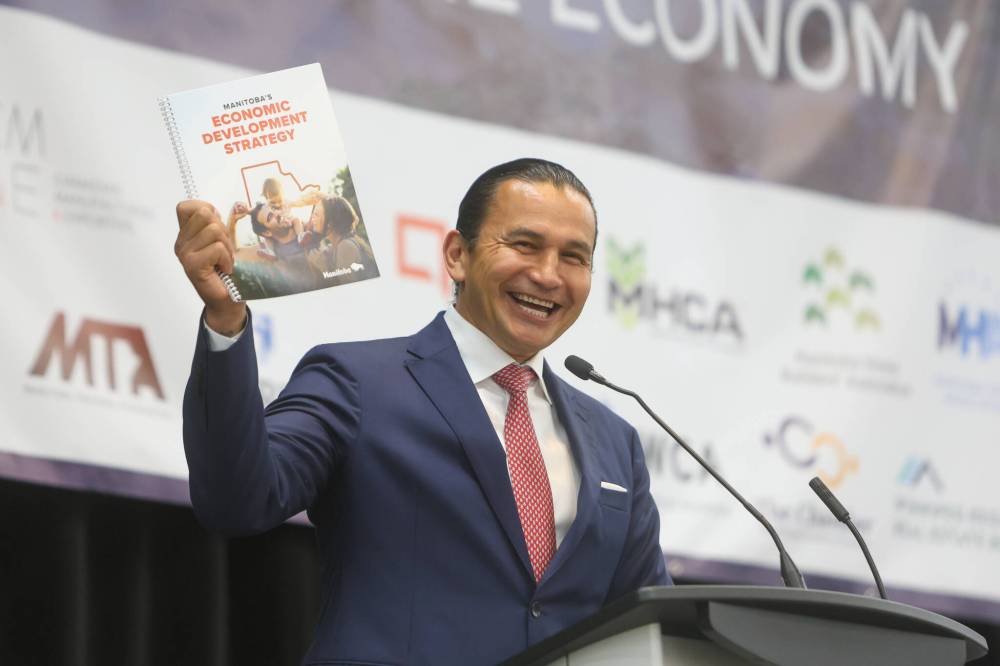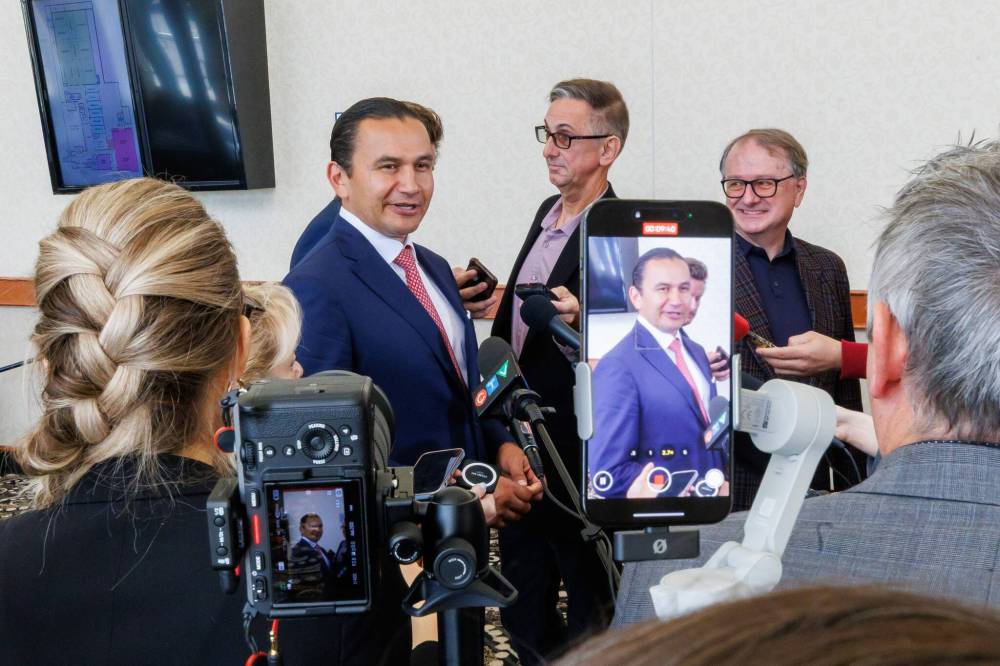Kinew vows to turn Manitoba into a ‘have’ province by 2040 NDP unveils economic development plan; biz leader hails it as ‘very bold initiative’
Read this article for free:
or
Already have an account? Log in here »
To continue reading, please subscribe:
Monthly Digital Subscription
$0 for the first 4 weeks*
- Enjoy unlimited reading on winnipegfreepress.com
- Read the E-Edition, our digital replica newspaper
- Access News Break, our award-winning app
- Play interactive puzzles
*No charge for 4 weeks then price increases to the regular rate of $19.95 plus GST every four weeks. Offer available to new and qualified returning subscribers only. Cancel any time.
Monthly Digital Subscription
$4.99/week*
- Enjoy unlimited reading on winnipegfreepress.com
- Read the E-Edition, our digital replica newspaper
- Access News Break, our award-winning app
- Play interactive puzzles
*Billed as $19.95 plus GST every four weeks. Cancel any time.
To continue reading, please subscribe:
Add Free Press access to your Brandon Sun subscription for only an additional
$1 for the first 4 weeks*
*Your next subscription payment will increase by $1.00 and you will be charged $16.99 plus GST for four weeks. After four weeks, your payment will increase to $23.99 plus GST every four weeks.
Read unlimited articles for free today:
or
Already have an account? Log in here »
The NDP government has launched an economic development strategy intended to boost Manitoba’s fortunes by making it a “have” province by 2040.
“Let’s make Manitoba more productive,” Premier Wab Kinew told a crowd of roughly 425 business leaders and politicians who attended an industry-led forum on economic growth Thursday.
Manitoba is considered a “have not” province because it relies on equalization payments from the federal government to fund essential services such as health care.

MIKE DEAL/ FREE PRESS
Premier Wab Kinew announces the release of Manitoba’s new economic development strategy Thursday. The province aims to boost its gross domestic product per capita by $5,000 relative to other provinces by 2040.
Kinew pointed to two major goals outlined in the 39-page strategy: improving productivity and pulling underrepresented groups into the workforce, including First Nations members.
Productivity compares inputs, such as time and money, to outputs that contribute to gross domestic product. The measure has declined in Manitoba since 2015.
Some private-sector leaders lauded the document as mapping the road for business growth, while detractors said it lacked details and the proposed changes will come too late.
Many businesses face uncertainty thanks to Canada’s largest trading partner. In some cases, firms have been hit with tariffs and decreased cross-border trade with the United States.
Kinew appealed to trade-exposed industries in his speech: Manitoba will fund a $50-million business loan program for “productivity-enhancing” investments. The first tranche of funding will focus on trade-exposed businesses and applications will open in October, the premier said.
“The whole Trump threat with tariffs has caused a lot of uncertainty.”
The new program prioritizes workforce development, intellectual property creation and commercialization, and growing trade, wages and jobs.
“The whole Trump threat with tariffs has caused a lot of uncertainty,” Kinew later told reporters. “We want businesses here to grow.”
A Canadian Federation of Independent Business survey found 35 per cent of Manitoba small businesses expect to decrease investments over the next two years.
The province is increasing its small business venture capital tax credit program limit by 36 per cent. It’s removing the provincial sales tax from manufacturing equipment for manufacturers.
The latter move will cost the government $3.6 million annually, Kinew said.
More trade offices, similar to one recently opened in Washington, D.C., will come online, Kinew told the corporate crowd.
The strategy includes a focus on intellectual property development and workforce participation — including by creating a higher-education roundtable with industry, government and post-secondary representation.
Kinew said he aims to boost Manitoba’s real GDP per capita by about $5,000, relative to other provinces, by 2040.
The province’s GDP growth lagged behind every other province in 2024 — a 1.1 per cent increase, compared to the national average of 1.6 per cent, Statistics Canada data show.
“The notion that growing the economy is job No. 1 for every level of government is beginning to resonate,” said Chris Lorenc, president of the Manitoba Heavy Construction Association.
“What is going to be very important, apart from the plan, is the manner in which it is resourced to be executable and measurable.”
“What is going to be very important, apart from the plan, is the manner in which it is resourced to be executable and measurable.”
Chuck Davidson, president of the Manitoba Chambers of Commerce, said the strategy sets a “very bold initiative” for where Manitoba could go and is a “living document.”
Davidson and fellow private-sector and labour representatives were on an advisory council during the creation of the strategy. He called the collaboration positive.

MIKE DEAL / FREE PRESS
“Let’s make Manitoba more productive,” Premier Wab Kinew told the crowd Thursday.
Both the Canadian Manufacturers & Exporters and North Forge, which works with start-ups, applauded the document. Proposed tax changes are a “game changer,” said Jillian Einarson, the CME’s policy and government relations lead for the Prairies.
“The modernization of the tax credits is sending a serious message that we are about innovation,” said Joelle Foster, president and CEO of North Forge.
The strategy proposes a “Made-in Manitoba” visa program that streamlines immigrants who want to start new businesses in the province, especially in the tech industry. Foster encouraged the idea; Manitoba is set to explore it with the federal officials.
The strategy does little for Manitoba businesses today, argued Obby Khan, leader of the Progressive Conservatives.
“I would’ve liked to see a concrete plan instead of a document filled with consultant speak,” Khan said. “All talk and no concrete action by this premier.”
The strategy offers no new information about the Port of Churchill, which is on the short-list for federal government fast-tracking. Ottawa has hinted its next round of announcements will be made before the Grey Cup game in November.
Kinew spoke at length about the Port of Churchill during his speech Thursday. The project would supercharge Manitoba’s economy and be worth tens of billions of dollars in the long run, he said.
The critical minerals supply chain — which the Port of Churchill would be part of — was flagged as an emerging sector in the new strategy.
Advanced manufacturing, renewable fuels, agriculture technologies and artificial intelligence were also highlighted.
The plan doesn’t put resources behind poverty-reducing workforce development programs, the Canadian Centre for Policy Alternatives said.
“A fairer distribution of income would improve productivity by providing more resources to middle-class and lower-income households to participate in the economy,” Molly McCracken, the Manitoba chapter’s director, said in a statement.
The CCPA and Climate Action Team Manitoba said the plan has a lack of focus on climate change and net-zero goals.
The Port of Churchill’s expansion, and increasing production of data centres and “false solutions” like sustainable aviation fuel are environmentally concerning, Climate Action Team Manitoba said.
“After a summer of devastating and costly climate impacts, Manitoba cannot afford to pursue economic development without… the climate crisis front and centre,” Laura Cameron, Climate Action Team Manitoba’s director of programs, wrote in a statement.
The strategy calls for a client focus when the government interacts with businesses, including a single point of contact for projects. Red tape causes companies to leave Manitoba, Davidson noted.
gabrielle.piche@winnipegfreepress.com

Gabrielle Piché reports on business for the Free Press. She interned at the Free Press and worked for its sister outlet, Canstar Community News, before entering the business beat in 2021. Read more about Gabrielle.
Every piece of reporting Gabrielle produces is reviewed by an editing team before it is posted online or published in print — part of the Free Press‘s tradition, since 1872, of producing reliable independent journalism. Read more about Free Press’s history and mandate, and learn how our newsroom operates.
Our newsroom depends on a growing audience of readers to power our journalism. If you are not a paid reader, please consider becoming a subscriber.
Our newsroom depends on its audience of readers to power our journalism. Thank you for your support.
History
Updated on Thursday, September 25, 2025 6:05 PM CDT: Adds quotes, details, photo.







